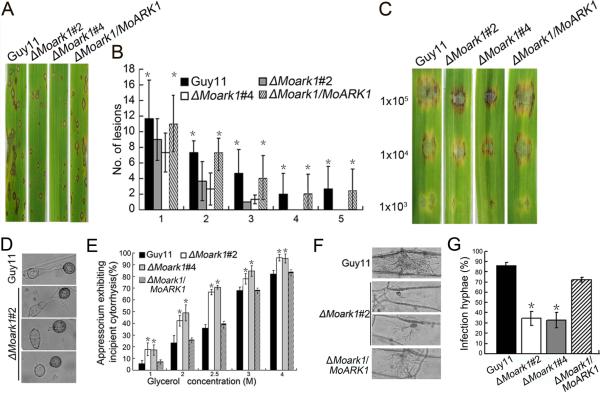Figure 4.
MoARK1 deletion attenuated pathogenicity.
(A) The MoARK1 deletion attenuated pathogenicity on rice leaves. (B) Quantification of lesion type (0 = no lesion; 1 = pinhead-sized brown specks; 2 = 1.5 mm brown spots; 3 = 2–3 mm gray spots with brown margins; 4 = many elliptical gray spots longer than 3 mm; 5 = coalesced lesions infecting 50% or more of the leaf area), reveals no difference in lesion types 1–3, however, the ΔMoark1 mutants do not make any lesion types 4 and 5. Lesions were photographed and measured or scored 7 dpi and experiments were repeated twice with similar results. n=35 for each mutant. (C) Conidia containing different concentration of ΔMoark1 mutants, were drop-inoculated onto barley and show a virulence defect compared to wild type strain (Guy11) and complemented strains, as manifested by smaller lesions at 5 dpi. (D) Appressoria formation is altered in the ΔMoark1 mutant. (E) Collapsed appressoria were observed in the wild type Guy11, ΔMoark1 mutant, and complemented strains. For each glycerol concentration, at least 100 appressoria were observed and numbers of collapsed appressoria were counted. (F) The ΔMoark1 mutants exhibited reduced host penetration on onion epidermis after 48 h in contrast with control strains. (G) Quantification of hyphae infection on onion epidermis after 48 h. Three independent biological experiments yielded similar results. Error bars represent standard deviation, and asterisks represent significant difference between Guy11 and mutants (p<0.01).

